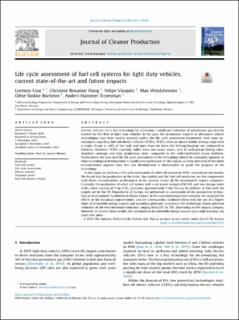| dc.description.abstract | Electric vehicles are a key technology for achieving a significant reduction of greenhouse gas directly emitted by the fleet of light duty vehicles. In the past, the production impacts of alternative vehicle technologies have been widely assessed within the life cycle assessment framework, with large uncertainties regarding fuel cell electric vehicles (FCEVs). FCEVs allow an almost double driving range with a single charge or refill of the tank and more than ten times the fueling/charging rate compared to batteries. However, FCEVs currently suffer from two major issues, lack of widespread fueling infrastructure coverage and high production costs, compared to the well-established Li-ion batteries. Furthermore, the data used for life cycle assessments of the technology should be constantly updated, as their technological development is rapidly moving forward. In this regard, an early detection of the likely environmental impacts from this fast development is fundamental to guide the progress of the technology.
In this study we perform a life cycle assessment of a fuel cell system for FCEV currently on the market. We found that the production of the tanks, the catalyst and the fuel cell auxiliaries are the components with lower environmental performance of the system, across all the investigated impact categories. Currently, the production of a fuel cell system with a net power output of 80 kW, and two storage tanks with a total capacity of 5 kg of H2, generates approximately 5 ton CO2-eq. In addition, in line with the targets set by the US Department of Energy, we performed an assessment of the prospective technological developments to identify its future impact. In the assessed prospective scenarios, we analyzed the effects of the technical improvements, and we subsequently combined them with the use of a higher share of renewable energy sources and secondary platinum. In essence, the technology shows potential reduction of the environmental footprints ranging from 25% to 70%, depending on the impact category. However, to achieve these results, the combination of renewable energy sources and a high learning rate must take place. | en_US |

